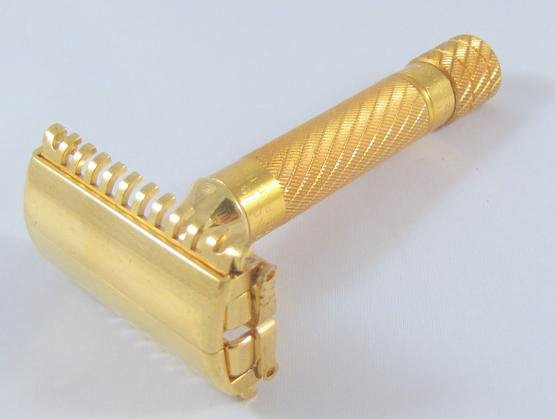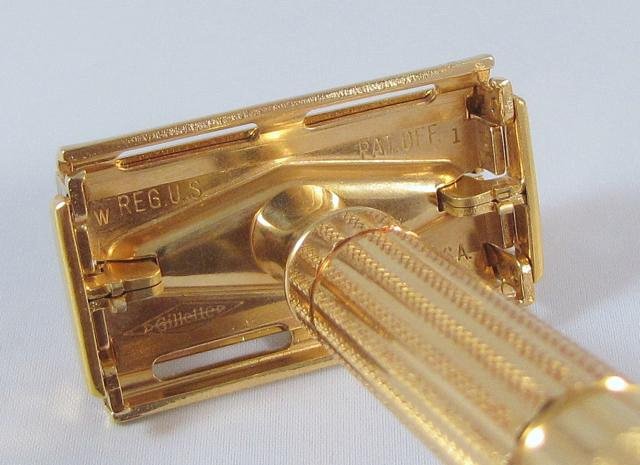Gillette Aristocrat History
Spanning approximately 70 years, the Aristocrat nameplate was the longest running of the Gillette line of DE razors and, in my opinion, was their flagship razor. True, more upscale and pricier sets were made, but only for short periods of time, while the Aristocrat enjoyed fairly steady production until a decade long break from 1951 to 1961. This appears to have been a very popular razor in its time, as there are usually several of these on auction at eBay on any given day, and is far more commonly seen than the other higher quality U.S. built Gillette razors like the President and Diplomat.
THE BEGINNING
According to the old geocities Gillette date chart, the first Aristocrat arrived on the scene in 1910 and was essentially a Single Ring head and body with a fluted or bell shaped knob. This came in a unique and beautiful cream-colored French Ivory (celluloid) case with matching blade banks. This version was made until the late 1900‘s, at which point the Aristocrat was the same as a Single Ring, which I’m thinking was the beginning of Gillette’s marketing strategy of putting identical razors in different cases and giving them different names. To the best of my knowledge, the original Aristocrat only came in silver plate.
1910 Gillette Aristocrat
1910 Gillette Aristocrat - note the faux ivory matching blade banks.
There was also a New Improved version of the Aristocrat marketed in the 1920’s that was sold in the same French Ivory case. It looked identical to the other New Improved models with the exception of the knurling being different on the knob piece. This version was available in both silver and gold plate, and would be the only one available in either plating. To the best of my knowledge, no NEW or De Luxe versions of the Aristocrat were made.
Notice that the knurling pattern on the knob piece of the Aristocrat is the same as its handle.
New Improved Aristocrat in French Ivory Case
New Standard Razor
THE FIRST ONE-PIECE RAZOR
In 1934, Gillette released its first twist-to-open (TTO) one-piece razor in the form of this beautiful open comb Aristocrat with the spiral handle knurling that we commonly refer to as “bulldog” knurling. It was sold in either a black leather-covered or gold-plated brass clam-shell style case, the latter of which, I believe, was only available at Christmas time.
1934 Aristocrat
Standard case Left, Christmas DeLuxe packaging Right
The open comb model gave way to the solid guard bar version around 1940, and was available in the same two cases. This was the first model to feature the handle knurling pattern that was used extensively on post-WWII razors like the Aristocrat, President, Diplomat, Fat Boy, and 1958 TV Special Super Speed. Note the absence of end caps that was indicative of pre-war Gillette razors.
This straight guard bar Aristocrat was also marketed as the rarely seen Regent Tech model in 1944 that was sold in a magnificent and very unique wood and leather case. This set has been the subject of much controversy among collectors because of a mismatched picture in the Krumholtz razor book, but I have seen a few sets like this, and believe it to be the correct one.
AFTER THE WAR (1946-1947)
The post-WWII Aristocrats were identical to the pre-war models with the exception of the newly added end caps. These were available in small blue or burgundy leather (or faux leather) clamshell cases with gold-plated blade banks. This particular set was available in 1946 and 1947 and featured what many consider (and I concur) to be the most aggressive version of the Aristocrat made. The 1946-1947 Aristocrat models came with the no-notch center bar and can be identified by the smooth bands on the upper and lower portions of the handle — although there were some variants that I will discuss shortly.
Mid 1940’s Aristocrats
1948-1950
The Aristocrat models from this time period are a little tamer than their predecessors, and feature a few design changes. Besides the addition of knurling to the upper band on the handle, the 1948 models came with notched center bars for hands-free blade loading. The case was changed to a larger square shaped clamshell model with a faux pigskin covering. Also, the wording stamped on the inside of the base plate changed from “PAT. NOS. ON PACKAGE” to “PAT. NOS. ON PKG”.
1948-50 Aristocrat
46-47 versus 48-51 blade tray
One of the crown jewels of my collection is this unused 1950 Christmas presentation set (dated by the ad below) that I found at a local antique store. I’m still amazed that this set went completely untouched for so many years.
1950 Christmas Aristocrat Set
Original Advert
1951 — THE LAST OF THE TRUE ARISTOCRATS
1951 was the last year of production for the fixed head Aristocrat, and it was completely identical to the 1948-1950 version (including the case). The only difference in a 1951 model is that it has a date code (“W” for 1951) stamped on the bottom of the base plate, and with the exception of a rare 1950 “V3” test date code model, these were the only fixed head Aristocrats to have date codes on them.
1951 Aristocrat
THE RETURN OF THE ARISTOCRAT
After a decade long absence, the Aristocrat made a comeback in 1961 in the form of a gold-plated Slim Adjustable that came in a elongated hard plastic presentation case, and was produced until 1967 or 1968. This model has the distinction of being the last all metal gold-plated DE razor that Gillette ever produced.
Aristocrat Adjustable
ODDS AND ENDS
Throughout the years, Gillette was known for making “spare part” razors when they had design changes, and there are oddballs and variants constantly popping up. The one I see most often concerning Aristocrats is the 1946-1947 model that comes in the burgundy case with burgundy lid liner. The razor in my burgundy lined case is identical to my 1948-1950 model on the right, and perhaps is a mismatch, but I have seen numerous Aristocrats with the no-notch center bar head paired to a 1948-1951 style handle with the knurling on the upper band, so it’s perfectly reasonable to believe that a 1948-1951 style razor came from the factory in a 1946-1947 case. My theory is that Gillette had cases and razor heads left over from 1946-1947 and they did some “mixing and matching“ to use them up.
Here’s an example of a 1946-1947 head mounted onto a 1948-1951 handle:
THE ARISTOCRAT WHO BECAME PRESIDENT
There is a rarely seen variant of the President razor that was produced in 1953 (first year of Presidents) that has a handle with an upper knurled band and smooth lower band like a 1948-1951 Aristocrat. My theory is the same as above in that Gillette was using up handles that were left over when Aristocrat production ceased in 1951.























